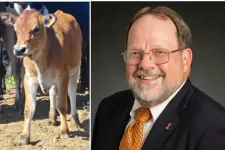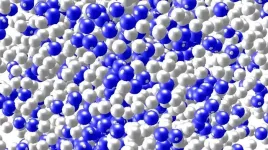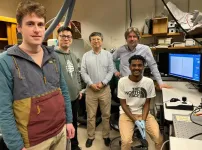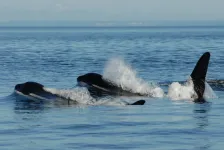(Press-News.org) Images
Physicists often turn to the Rayleigh-Taylor instability to explain why fluid structures form in plasmas, but that may not be the full story when it comes to the ring of hydrogen clumps around supernova 1987A, research from the University of Michigan suggests.
In a study published in Physical Review Letters, the team argues that the Crow instability does a better job of explaining the "string of pearls" encircling the remnant of the star, shedding light on a longstanding astrophysical mystery.
"The fascinating part about this is that the same mechanism that breaks up airplane wakes could be in play here," said Michael Wadas, corresponding author of the study and a graduate student in mechanical engineering at the time of the work.
In jet contrails, the Crow instability creates breaks in the smooth line of clouds because of the spiraling airflow coming off the end of each wing, known as wingtip vortices. These vortices flow into one another, creating gaps—something we can see because of the water vapor in the exhaust. And the Crow instability can do something that Rayleigh-Taylor could not: predict the number of clumps seen around the remnant.
"The Rayleigh-Taylor instability could tell you that there might be clumps, but it would be very difficult to pull a number out of it," said Wadas, who is now a postdoctoral scholar at the California Institute of Technology.
Supernova 1987A is among the most famous stellar explosions because it's relatively close to Earth at 163,000 light years away, and its light reached Earth at a time when sophisticated observatories existed to witness its evolution. It is the first supernova visible to the naked eye since Kepler's supernova in 1604, making it an incredibly rare astrophysical event that has played an outsized role in shaping our understanding of stellar evolution.
While much is still unknown about the star that exploded, it is believed that the ring of gas surrounding the star ahead of the explosion came from the merger of two stars. Those stars shed hydrogen into the space around them as they became a blue giant tens of thousands of years before the supernova. That ring-shaped cloud of gas was then buffeted by the stream of high-speed charged particles coming off the blue giant, known as a stellar wind. The clumps are believed to have formed before the star exploded.
The researchers simulated the way the wind pushed the cloud outward while also dragging on the surface, with the top and bottom of the cloud being pushed out faster than the middle. This caused the cloud to curl in on itself, which triggered the Crow instability and caused it to break apart into fairly even clumps that became the string of pearls. The prediction of 32 is very close to the observed 30 to 40 clumps around the supernova 1987A remnant.
"That's a big piece of why we think this is the Crow instability," said Eric Johnsen, U-M professor of mechanical engineering and senior author of the study.
The team saw hints that the Crow instability might predict the formation of more beaded rings around the star, further out from the ring that appears brightest in telescope images. They were pleased to see that more clumps seem to appear in the shot from the James Webb Space Telescope's near-infrared camera, released in August last year, Wadas explained.
The team also suggested that the Crow instability might be at play when the dust around a star settles into planets, although further research is needed to explore this possibility.
The study was supported by the Department of Energy, with computing resources provided by the Extreme Science and Engineering Discovery Environment
Co-authors of the study are: William White and Aaron Towne, a graduate student and an assistant professor in mechanical engineering, respectively; and Heath LeFevre and Carolyn Kuranz, a research fellow and an associate professor of nuclear engineering and radiological sciences, respectively; all at U-M.
Study: Hydrodynamic mechanism for clumping along the equatorial rings of SN1987A and other stars (DOI: 10.1103/PhysRevLett.132.111201)
END
Explaining a supernova's 'string of pearls'
It looks like the same mechanism that breaks up airplane contrails might be at play in forming the clumps of hydrogen gas that ring the remnant of supernova 1987A
2024-03-13
ELSE PRESS RELEASES FROM THIS DATE:
Marine heat waves disrupt the ocean food web in the northeast Pacific Ocean
2024-03-13
NEWPORT, Ore. – Marine heat waves in the northeast Pacific Ocean create ongoing and complex disruptions of the ocean food web that may benefit some species but threaten the future of many others, a new study has shown.
The study, just published in the journal Nature Communications, is the first of its kind to examine the impacts of marine heat waves on the entire ocean ecosystem in the northern California Current, the span of waters along the West Coast from Washington to Northern California.
The researchers found that the biggest beneficiary of marine heat waves is gelatinous zooplankton – predominantly ...
The 11th World Congress on Microbiota Medicine critically evaluates probiotic supplementation strategies
2024-03-13
The International Society of Microbiota (ISM) announces its 11th World Congress, "Targeting Microbiota 2024", scheduled for October 14-15 at the Corinthia Palace in Malta. This event is set to highlight the latest research and developments in microbiotal medicine, emphasizing its impact on human health and its potential in shaping future medical treatment approaches.
Detailed Workshop: Probiotic Prescribing Practices dedicated to Medical Professionals
The congress will feature a critical workshop on October 15, titled “Probiotic Prescribing Practices: Empowering Medical Doctors for Improved Patient Health.” ...
Engineering Biology Research Consortium releases roadmap to mitigate, present and adapt to climate change
2024-03-13
Engineering Biology for Climate & Sustainability is the fifth technical roadmap developed by the Engineering Biology Research Consortium (EBRC) and represents the first dedicated to innovations and opportunities towards overcoming a significant global challenge. The roadmap targets and challenges are aligned and were drawn from existing climate and sustainability literature, particularly those focused on long-term impacts and opportunities, including reports from the United Nations’ Intergovernmental Panel on Climate Change and the U.S. Environmental Protection Agency.
The roadmap consists of six themes ...
Strengthening the partnership between humans and AI: the case of translators
2024-03-13
ChatGPT and its ability to hold conversations and produce written content have been the focus of a lot of attention in the last year in the field of technology and artificial intelligence. However, AI has been around for some time, helping us in all sorts of everyday tasks, from navigation systems to social network algorithms, not to mention machine translation. Ever since neural machine translation (NMT) systems began to be used on a widespread basis a few years ago, AI has seen exponential growth in its uptake in the translation industry. This has led to new challenges in the relationship between human and machine translators.
Today, the post-editing ...
Milk to the rescue for diabetics? Cow produces human insulin in milk
2024-03-13
An unassuming brown bovine from the south of Brazil has made history as the first transgenic cow capable of producing human insulin in her milk. The advancement, led by researchers from the University of Illinois Urbana-Champaign and the Universidade de São Paulo, could herald a new era in insulin production, one day eliminating drug scarcity and high costs for people living with diabetes.
“Mother Nature designed the mammary gland as a factory to make protein really, really efficiently. We can take advantage ...
Molecular simulations of ammonia mixtures support search for renewable fuels
2024-03-13
Ammonia (NH3) is an important molecule with many applications. The end product of the famed Haber–Bosch process, it is commonly synthesized to capture nitrogen for fertilizers, and is used for refrigeration, in cleaning products, and in the production of pharmaceuticals. Recently, this modest molecule has also attracted interest as a potential resource for addressing one of today’s most pressing challenges — the need for reliable and abundant renewable fuels.
Ammonia is stable and safe ...
First recognition of self in the mirror is spurred by touch
2024-03-13
Most babies begin recognizing themselves in mirrors when they are about a year and half old. This kind of self-recognition is an important developmental milestone, and now scientists at The University of Texas at Austin have discovered a key driver for it: experiences of touch.
Their new study found babies who were prompted to touch their own faces developed self-recognition earlier than those who did not. The research was published this month in the journal Current Biology.
“This suggests that babies pulling ...
Dartmouth engineering team discovers new high-performance solar cell material
2024-03-13
A Dartmouth Engineering-led study published in Joule reported the discovery of an entirely new high-performance material for solar absorbers—the central part of a solar cell that turns light into electricity—that is stable and earth-abundant. The researchers used a unique high-throughput computational screening method to accelerate the discovery process and were able to quickly evaluate approximately 40,000 known candidate materials.
"This is the first example in the field of photovoltaics where a new material has been found through this type ...
Advancing toward wearable stretchable electronics
2024-03-13
Small wearable or implantable electronics could help monitor our health, diagnose diseases, and provide opportunities for improved, autonomous treatments. But to do this without aggravating or damaging the cells around them, these electronics will need to not only bend and stretch with our tissues as they move, but also be soft enough that they will not scratch and damage tissues.
Researchers at Stanford have been working on skin-like, stretchable electronic devices for over a decade. In a paper published ...
Menopause explains why some female whales live so long
2024-03-13
Females of some whale species have evolved to live drastically longer lives so they can care for their families, new research shows.
The study focussed on five whale species that – along with humans – are the only mammals known to go through menopause.
The findings show that females of these whale species that experience menopause live around 40 years longer than other female whales of a similar size.
By living longer without extending their “reproductive lifespan” (the years in which they breed), these ...
LAST 30 PRESS RELEASES:
A new way to map how cells choose their fate
Numbers in our sights affect how we perceive space
SIMJ announces global collaborative book project in commemoration of its 75th anniversary
Air pollution exposure and birth weight
Obstructive sleep apnea risk and mental health conditions among older adults
How talking slows eye movements behind the wheel
The Ceramic Society of Japan’s Oxoate Ceramics Research Association launches new international book project
Heart-brain connection: international study reveals the role of the vagus nerve in keeping the heart young
Researchers identify Rb1 as a predictive biomarker for a new therapeutic strategy in some breast cancers
Survey reveals ethical gaps slowing AI adoption in pediatric surgery
Stimulant ADHD medications work differently than thought
AI overestimates how smart people are, according to HSE economists
HSE researchers create genome-wide map of quadruplexes
Scientists boost cell "powerhouses" to burn more calories
Automatic label checking: The missing step in making reliable medical AI
Low daily alcohol intake linked to 50% heightened mouth cancer risk in India
American Meteorological Society announces Rick Spinrad as 2026 President-Elect
Biomass-based carbon capture spotlighted in newly released global climate webinar recording
Illuminating invisible nano pollutants: advanced bioimaging tracks the full journey of emerging nanoscale contaminants in living systems
How does age affect recovery from spinal cord injury?
Novel AI tool offers prognosis for patients with head and neck cancer
Fathers’ microplastic exposure tied to their children’s metabolic problems
Research validates laboratory model for studying high-grade serous ovarian cancer
SIR 2026 delivers transformative breakthroughs in minimally invasive medicine to improve patient care
Stem Cell Reports most downloaded papers of 2025 highlight the breadth and impact of stem cell research
Oxford-led study estimates NHS spends around 3% of its primary and secondary care budget on the health impacts of heat and cold in England
A researcher’s long quest leads to a smart composite breakthrough
Urban wild bees act as “microbial sensors” of city health.
New study finds where you live affects recovery after a hip fracture
Forecasting the impact of fully automated vehicle adoption on US road traffic injuries
[Press-News.org] Explaining a supernova's 'string of pearls'It looks like the same mechanism that breaks up airplane contrails might be at play in forming the clumps of hydrogen gas that ring the remnant of supernova 1987A





